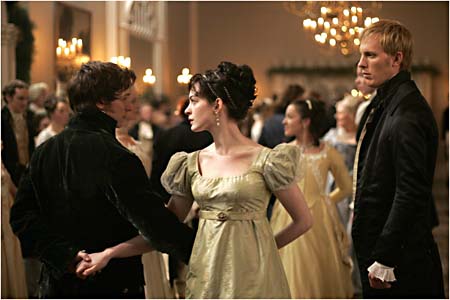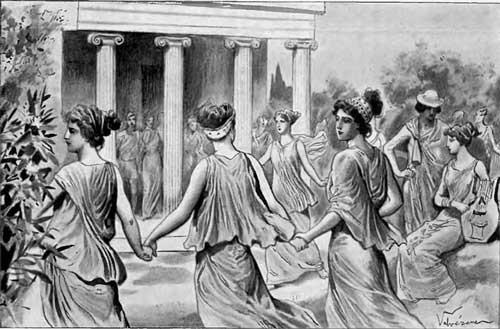
It is now time for a guest post on the history of dance from E. J. Kitchens, author of Wrought of Silver and Ravens.
I have not read that book yet, but it sounds fascinating and I loved The Rose and the Wand also by E.J. Kitchens.
And now, enough of me, onwards to the dance.
A Dance Through Time
Watching little two- and three-year-olds dance is one of the delights of being a parent, or in my case, an aunt. There’s little comparison between their energetic bounces and jerks to the waltz, tango, the wedding dance of the Jews from The Fiddler on the Roof, the war dances of primitive tribes, or any of the hundreds of dances found around the world and throughout time. But it’s still a dance and still a delight to watch and, I imagine, a delight for the little ones to engage in.
Dancing leaves very little evidence useful for historical dating (we know how easily dancing shoes wear out, after all), so determining a beginning or the form of early dances is difficult. I suspect we’ve always danced, as well as always sung. There are, however, pre-historic cave paintings in India depicting dances as well as paintings in Egyptian tombs from about 3300 BC. Dances, historically, have tended to be ceremonial, such as for a wedding; celebratory, such as performed after a harvest; religious or for a ritual, such as a rain dance or the whirling dance of the Sufi Dervishes trying to achieve a trance-like state for meditation; a method of healing; or as a method of expression, used to tell a story (often a myth). Aristotle claimed that dance ranked with poetry, that it had a great power of expression.

When most of us think of dancing, especially with regard to romance or fairytales, we think of the waltz—the women’s flowing ball gowns, the handsome men in suits, the beautiful music, the candlelight ballroom.

The term “waltz” is from the old German word “walzen,” which means “to roll, turn, or to glide.” I love the name; it truly fits. Dancing the waltz is very much an experience of gliding across the dance floor, the lady dependent on the gentleman to guide (for she is going backwards as they move in a circle around the floor), to communicate what he wishes her to do. I took ballroom dancing for a few years, and the waltz is one of my favorite dances. It makes you feel so graceful. And there’s just something about a dance in general—there’s a challenge to mastering it, but once you do that, to feel a slight shift in the gentleman’s hand on yours or on your back and to know exactly what you’re supposed to do and when, and do that, without hesitation or nerves, to create a beautiful pattern of movements through that silent communication, it’s just a wonderful feeling. You also learn a lot about a guy by how he holds you—is his hold limp and doesn’t communicate anything in time, or firm and confident? Anyway, the waltz is—probably thanks in part to Disney—the quintessential dance of romance (although, the rumba is the one called “the dance of love,” but it’s more of a sensual dance—but do note that the dance one dances at a local ballroom dance club is much different than the ones you see in competitions or on tv).
A relatively young dance, the waltz developed in the suburbs of Vienna and the alpine region of Austria and was seen in the ballrooms of the Hapsburb court as early as the seventeenth century. Some waltz tunes actually developed from simple peasant yodeling melodies. This dance in three-quarter time slowly made its way across Europe and to England and the US. However, it meant with much resistance in some areas, particularly England. It is different and simpler (less for the dancing masters to teach) from elaborate court dances and is a more independent dance, and the dancers are “scandalously” close to one another.
In the time of Jane Austen and Pride and Prejudice, it would have been a scandal. Fortunately, Ms. Austen still gave us wonderful proof that the waltz isn’t the only dance for romance. Queen Victoria, however, was said to have enjoyed the waltz. The first known waltz danced in the US was in Boston in 1834.

Dancing has always been an important part of life, and figures prominently in many stories, including “The Twelve Dancing Princesses.” Alas, there is no waltz in my Twelve Dancing Princesses retelling because it is set far too early for that—in a fantasy world similar to Ancient Greece. The ancient Greeks placed a high value on music and dancing. They believed dancing was invented by the gods and that skilled dancers had been given gifts by the gods enabling them to dance well. The geronos was a popular dance for children where the boy and girl got to dance together (dancing as a couple for adults was not common). It used snake-like movements to recreate the story of Theseus escaping the Minotaur. The epilinious was danced atop a vat of grapes (I don’t think I would want to drink the wine made from that). And instead of a father-dance dance, they had the imeneos, where a bride and her mother danced together. They also had a ring dance, danced in a circle possibly around the musicians or an object.
In my story, Wrought of Silver and Ravens, the princesses are forced to dance every night with dragons who take on a human-like form. This dancing with a partner of the opposite sex means the dance is not authentic to Ancient Greece, but it was what I needed for the story, and since it’s fantasy anyway, I can get away with a mix-and-match type of history. While the men-only or women-only dances can be incredible, they weren’t quiet what I needed. It’s difficult for a prince to steal a princess’s magic and kingdom one dance at a time if he doesn’t actually dance with her. My image of their dancing is more along the lines of a folk dance, still a couple dance but not with a close hold or so gliding.
Dancing has an incredibly rich and varied history, and is an important within cultures throughout history as in stories. Do you have a favorite dance or dance or to watch?
References :
https://www.centralhome.com/ballroomcountry/waltz.htm
https://www.historyforkids.net/greek-dance.html
About E. J. Kitchens

E.J. Kitchens loves tales of romance, adventure, and happily-ever-afters and strives to write such tales herself. When she’s not thinking about dashing heroes or how awesome bacteria are—she is a microbiologist after all—she’s taking photos, reading, or talking about classic books and black-and-white movies. She is the author of the historical fantasy series THE MAGIC COLLECTORS and of several fairytale retellings. She is a member of Realm Makers and lives in Alabama.
Find her online at: Website || Blog || Goodreads || Facebook || Newsletter || Amazon
About the Book

Athdar Owain is a hunted wanderer, one determined to keep his secrets and the treasure he carries safe at all costs. When he rescues the Kingdom of Giliosthay’s prince from raiders, he’s rewarded by being forced into the king’s elite Silver Guard. While this gives Athdar a temporary home and some protection from those hunting him, it also makes him responsible for the young prince, who still bears curses from the raiders, and seven enchantress princesses with curses as mysterious and dangerous as their brother’s.
Princess Thea of Giliosthay is a Realm Walker. Betrayed by a trusted guard, her rare gift of enchantment is used to curse her brother and trap herself and her six sisters into a nightly dance with dragons in a secret Realm. The Realm’s prince has the ability to take and twist her magic for his own purposes, and Thea fears what those might be. For when one dances with a prince, a kingdom might be at stake.
Athdar alone can save them, but to trust enchanters is to risk exposure. And Athdar isn’t sure where his loyalties lie.
Wrought of Silver and Ravens is a clean adventure-romance retelling of The Twelve Dancing Princesses set in The Magic Collectors story world.
You can purchase the book on Amazon and from other retailers.
For reviews and more, check out the blog tour page here and don’t forget to comment below with what kind of dancing you like.



I quite enjoyed this post! Getting to hear something about the history of dance was pretty cool. Thanks, Elizabeth and Brie, for sharing!
My own preferences for dancing is Australian bush dance. It’s got a bit of
English Country in it, and is sometimes simple and other times complex. There’s fun dances with names like Waves of Bondi. There’s dances to a waltz rhythm that use different steps and I can actually do. And now I’m making myself miss it, because dance work shops are definitely not happening at the moment.